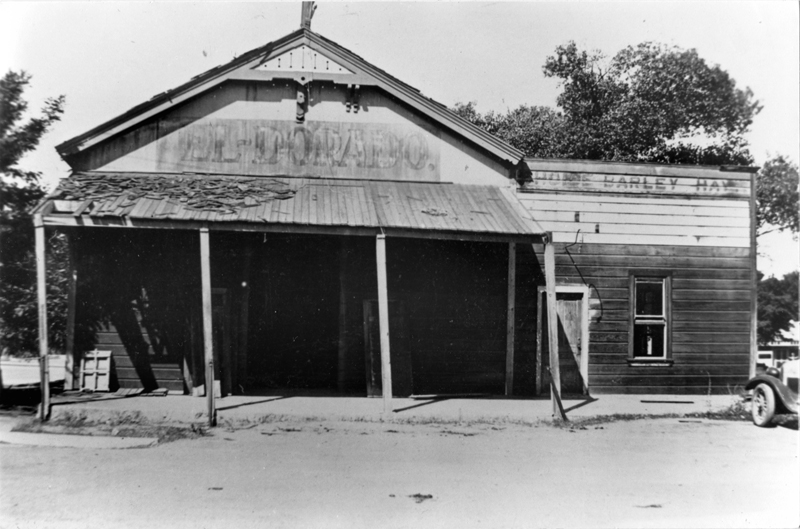|
|

Click image to enlarge Remains of the El-Dorado, presumably a short-lived saloon, in the former Gulley/Swall general store building at the northwest corner of Railroad Avenue and Market Street (facing Railroad), after 1914 and probably about 1919 (see below). Note that the saloonkeeper hadn't bothered to paint out all of the general store signs; either that, or a portion of the building was still used for that purpose. J.O. Newhall, a relative of town founder Henry M. Newhall, built this general store in the 1880s, across Market Street from the Southern Hotel. Sometime in the 1890s it was purchased and operated by James M. Gulley. Reynolds[1] tells us Albert C. Swall was 19 when he arrived in Newhall in 1890. He was one of three sons of J.A. "Jake" Swall Sr., and together they harvested wheat on Newhall Land & Farming Co. property in the western Santa Clarita Valley in the 1890s. According to Perkins[2], Albert left the family harvesting business in 1904 to establish a meat market inside Gulley's store. Swall was still Gulley's tenant in 1906 when Gulley sold the property[3] to William Mayhue, a friend of Henry Clay Needham who, like his friend, hailed from the Kentucky-Tennessee area. Mayhue worked in the Rice Canyon oil fields in the 1890s. In 1914 Mayhue raised the rent on what was now Swall's general store. Swall responded by closing up shop and moving one block west to Market and Spruce, where Swall built a hotel. Others followed his lead and helped turn Spruce (later called San Fernando Road and still later, Main Street) into Newhall's main street. Up to that point, business activity centered around Railroad Avenue. The general store property apparently went downhill when Swall abandoned it. A photo shows what was left of it after it was something called the El-Dorado, apparently a saloon. Around 1919, Lloyd Houghton, who married Mayhue's daughter Opal, bought the property and turned it into the Hap-A-Lan dance hall. Hap-A-Lan was a nightclub after dark and a popular meeting place during the day — until the St. Francis Dam Disaster of March 12, 1928, when it was used as a makeshift morgue. After that, nobody wanted to party in it any more and it was torn down. In 1931 the county courthouse was erected on the property. Legend tells us the flooring from the original one-story general store/dance hall was salvaged and installed upstairs in the two-story courthouse. The second-story section came to be known as the "Rafters" when the Canyon Theatre Guild used the space from 1971-1974. The same space was later used by Alchoholics Anonymous.
1. Reynolds, Jerry. "Santa Clarita: Valley of the Golden Dream," World of Communications Inc., Granada Hills, Calif., 1992.
AP0704: 9600 dpi jpeg from copy print |
See Also:
J.O. Newhall 1880s
Gulley-Swall 1904/06
Mayhue Store 1914/19
El-Dorado ~1919
Morgue 1928
Hap-A-Lan Piano
(3) Lloyd Houghton Paintings
|
The site owner makes no assertions as to ownership of any original copyrights to digitized images. However, these images are intended for Personal or Research use only. Any other kind of use, including but not limited to commercial or scholarly publication in any medium or format, public exhibition, or use online or in a web site, may be subject to additional restrictions including but not limited to the copyrights held by parties other than the site owner. USERS ARE SOLELY RESPONSIBLE for determining the existence of such rights and for obtaining any permissions and/or paying associated fees necessary for the proposed use.






